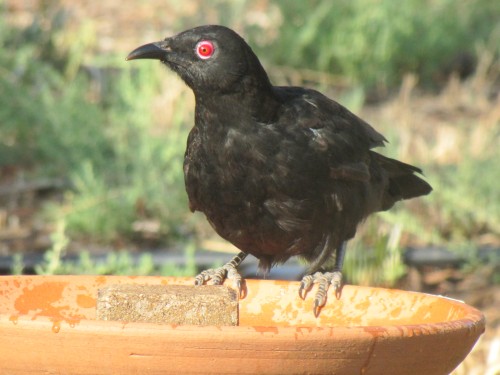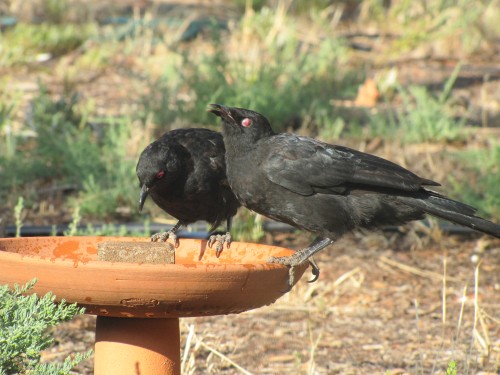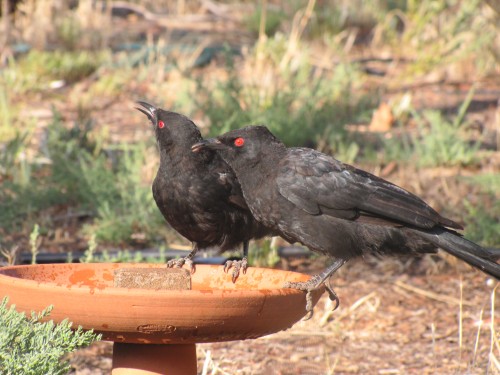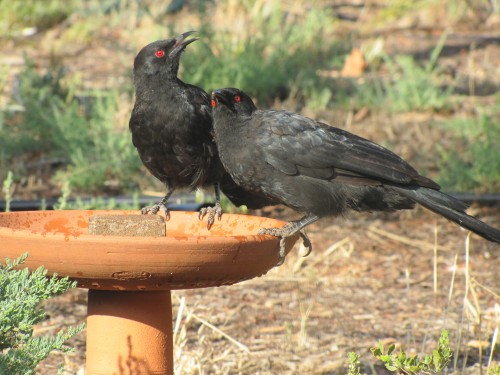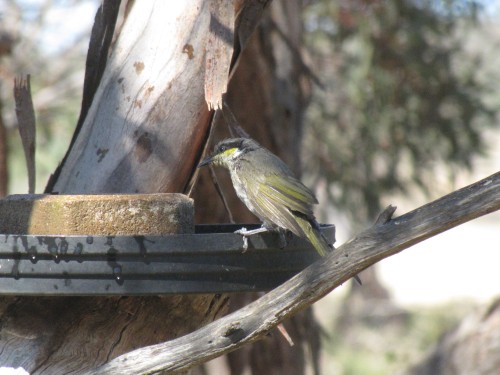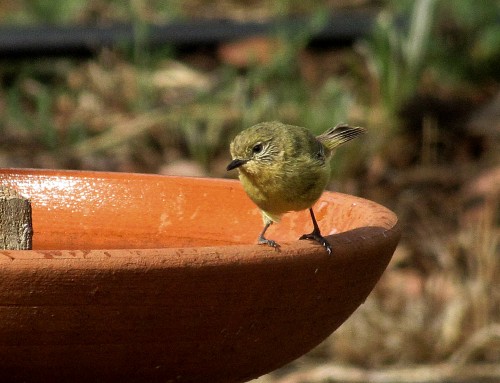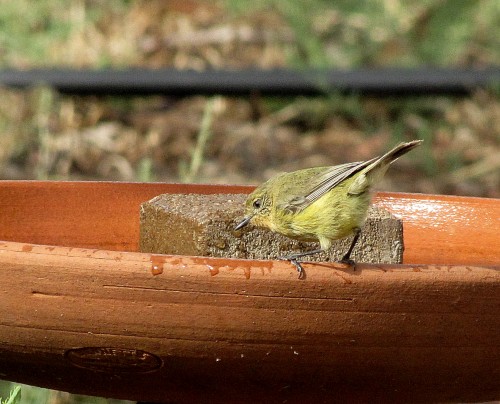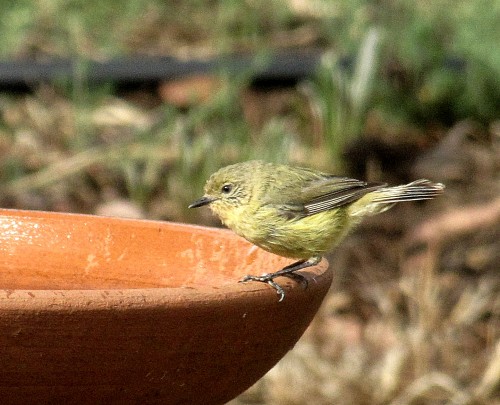White-winged Choughs at the bird bath
We’ve been having some really long spells of hot weather recently, right up to the last few days when autumn should be gently sneaking in, along with cooler, more mellow days.
During the hot weather I like to keep up the water supply to our various bird baths in our garden. Most of the birds appreciate to fresh water and come for a drink, or a bath and often both. It is not unusual to have a parade of ten or a dozen different species attend the water source in a ten minute period. It can become a busy, noisy airport at times.
When I choose to write or read in our sun room with a good view of several bird baths, I will often have the camera at the ready. The passing procession of birds is a wonderful distraction, but it is times like this that I also get some excellent photos, like those of two White-winged Choughs last week. With the camera on 20x zoom, their bright glowing red eyes take on quite an evil look.
Further reading:
- Time for a bath – a long list of species, both birds and animals, using our bird baths
This post was updated on 20th September 2015.
Singing Honeyeater at the birdbath
Yesterday I wrote about New Holland Honeyeaters bathing in our bird bath (click here to view that post).
While the New Hollands are by far the most frequent and noisiest of the visitors to the bird bath, many other species also come to bathe or drink during our hot spells in summer. The New Holland Honeyeaters may come individually, but they are more prone to come in a flock of a dozen or more. The result is usually very noisy – and water sprays everywhere.
By way of contrast, the Singing Honeyeater shown in today’s photo quite often comes alone, or at most, two. They tend to be far more solitary birds in our garden. They often wait a short distance away while other species drink, then slip in quietly to drink when calmness returns.
Hot weather birding
We are currently experiencing another heatwave. Tomorrow is forecast to be the 11th consecutive day over 30C; some of the days – like today – the temperature has reached 40C (104F). During such days I add a bucket of fresh rainwater to the various birdbaths we have in our garden. Several of them are in clear view of where we often sit to eat, or to enjoy some reading. Sometimes I even do my writing there; it gives me a break from my office and I have a different view. The camera is usually ready for action, so on occasions I neglect my writing and attend to some serious bird photography.
During the current heatwave the birds have been coming daily to drink, bathe and generally have a good time. The parade of species is impressive. We sometimes have up to a dozen different species come to drink in a 10 or 15 minute period. Last week I captured a series of photos of about a dozen New Holland Honeyeaters having a great time cooling off in the water. Droplets fly in all directions and some are left looking absolutely drenched.
For more photos like this one click here.
Beautiful Superb Fairy-wren
This morning I was sitting in our sun room doing some reading. I looked up and saw the male Superb Fairy-wren shown above and grabbed the camera before it flitted off into the vegetation. I had to take about four steps to get the camera and I was delighted that the bird stayed in position until I could focus and shoot. I only had time to manage one photo, but I’m quite happy with it. This species – like all of our wrens – are very flighty birds, never staying in one spot for more than a second or two – at best.
This individual, along with two uncoloured birds, has been resident in our garden now for over a year. This is delightful because, until a year ago, we had only recorded this species on a handful of occasions over the previous 28 years, despite them being common in our region. My next challenge is to get a shot of a female, preferably alongside the male.
The flowers belong to a Melaleuca lanceolata bush in our garden. It’s a common plant species in our area. For more about Australian native plants, have a look at my wife’s site, Mallee Native Plants.
My readers might like to also see photos of the Red-backed Fairy-wren over at Snail’s Eye View. This is one species I still have the delight to see in the wild.
Some of the photos shown here on Trevor’s Birding can now be purchased on tee shirts, coffee mugs, stationary and a large range of other items. Go to Trevor’s Photos site here.
Little Thornbills take a bath
We have many different birds resident or visiting in our garden and adjacent mallee scrub. We have quite a few thornbills, species which are always a challenge to identify. Many of them are little brown birds which move quickly and are hard to hold in focus for long with binoculars. Most are even harder to focus on with a camera.
I have over the years managed reasonable photos of the common Yellow-rumped Thornbill. I have fewer good photos of the occasional visiting Chestnut-rumped Thornbills. And until earlier this week I had no photos of the elusive Little Thornbill which is also called the Yellow Thornbill. This species is commonly heard and seen in our garden and nearby, but never have I managed to capture one with my camera.
Earlier this week a loose flock of about 6 of this lovely species came to one of our bird baths. they flitted in and out of the water, zipping to branches high above to preen before diving down to the water ago. I had to be very patient with my camera, making sure it was focussed on the edge of the bird bath in anticipation before snapping them. I was pleased to manage three reasonable shots.
Further reading:
